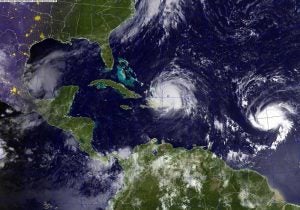Resilience in the eye of the storm: how Puerto Rico can build a stronger, more sustainable energy future
 By Agustín Carbó and Amalia Saladrigas
By Agustín Carbó and Amalia Saladrigas
The Atlantic hurricane season is under way and scientists predict it will be one of the strongest in recent memory, as climate change makes more frequent and severe storms the new normal. For communities across Puerto Rico, already battered by an array of crises, the need to plot a more resilient future is urgent.
Energy is a critical lifeline for Puerto Ricans, and residents’ health and well-being depend on a stable and reliable source of power. Previous disasters, from hurricanes to earthquakes, have shown how unreliable and fragile the current centralized energy system is.
Now, the archipelago has an opportunity to reimagine its electric infrastructure in a way that puts communities first with more sustainable and resilient solutions.
Hurricane season compounds risks, highlights need for solutions
Amid an ongoing fiscal crisis and struggling economy, the public health response to COVID-19 has stretched local resources available for hurricane preparedness. Providing communal storm shelter during a pandemic also raises serious public health concerns, and many residents lack adequate housing to begin with.
Resilience in the eye of the storm: how Puerto Rico can build a stronger, more sustainable energy future Share on XNearly three years after Hurricane Maria, roughly 3,000 families still have blue tarps as roofs and a series of earthquakes in January left many in the southwest region of the island living in unstable or unreliable structures. These disasters also underscore how fragile and vulnerable the electric grid remains, largely due to its centralized design and chronic lack of upkeep over the years.
In 2017, Maria decimated the grid and left most of Puerto Rico’s residents in a months-long blackout. Efforts to rebuild and modernize have lagged, and this year’s earthquakes severely damaged one of the island’s main power plants and plunged much of the island into darkness — highlighting the risks of a system that generates most of its power in a few locations.
A decentralized approach is critical for limiting the extent of potential damage in the future and accelerating communities’ ability to withstand and bounce back from disaster.
Opportunities to drive resilience and sustainability
The Puerto Rico Energy Bureau is in the process of reviewing the Puerto Rico Electric Power Authority’s Integrated Resource Plan, a 20-year road map for providing electricity to customers throughout the island. PREPA’s filed IRP did not go far enough to decentralize generation and maintained an over-reliance on fossil fuels. This would only perpetuate current problems, such as poor air quality and high costs, and do little to empower communities to play a greater role in their energy future.
Puerto Ricans already pay a premium for power that is too often unreliable and generated with dirty fuels. Rather than invest in a system that has proven susceptible to disaster and adds to the archipelago’s problems, Puerto Rico should look to a decentralized grid that puts communities first.
Sustainable microgrids that integrate distributed energy resources, such as rooftop solar and energy storage, and backed by intelligent software offer an alternative that can bolster local resilience, help build a clean energy future and deliver a stronger, more durable grid for all Puerto Ricans. By acting as mini energy service stations they can connect to and support the main grid, but also separate during emergencies to keep the lights on in regions where it’s needed most.
Crucially, grid-connected microgrids don’t just offer individual benefit. In addition to offering refuge during an emergency, they can strengthen the central grid for all customers by easing strain on it and providing ancillary services like frequency regulation to boost reliability. Microgrids can also improve the overall efficiency of the grid, defer or replace expensive infrastructure investments, and help deploy renewable energy intelligently. In short, done right, they are an essential resource for an unreliable grid like Puerto Rico’s that needs to quickly embrace decentralized and clean energy.
Communities key to advancing solutions
EDF has partnered with non-profit organizations on the island of Culebra — Mujeres de Islas, Fundación de Culebra, and Foundation for a Better Puerto Rico — on a pilot microgrid project that aims to improve residents’ access to cleaner, more reliable and resilient energy.
Culebra is located 17 miles east of the largest island in the Puerto Rican archipelago and its residents receive their energy through an underwater cable routed from the larger island. The local community has a distinct understanding of the importance of a reliable and sustainable energy supply, as well as the precarious nature of Puerto Rico’s current infrastructure.
Local residents have been working for years to improve their island’s resilience and self-sufficiency, and the development of a sustainable microgrid will provide a critical resource as they prepare for future hurricane seasons and a clean energy future.
While the changes needed to improve the grid’s strength and reliability will not happen in time for this year’s hurricane season, it’s critical that leaders across the archipelago prioritize decentralized, sustainable solutions. As the process of modernizing the grid unfolds, Puerto Rico has the chance to reimagine its energy infrastructure in a way that puts communities first.










